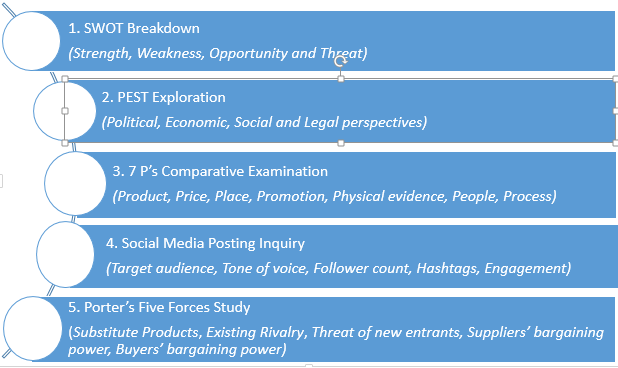Writing A Competitive Analysis For Your Business – A Guide
Steve Jobs once said, ‘Quality is the best business plan. Period.’ He meant that every entrepreneur should consider the customer’s needs and wants before delivering the service to hit the jackpot. However, contemporary circumstances and philosophies have proved this statement incomplete.
Instead, the experts of this generation follow the legendary saying – keep your friends close and your enemies closer. The phrase implies that as the CEO or the owner of the company, you need to be more aware of your competitors than the allies are. Being conscious about their moves and intentions saves you from getting into hot water.
Now that the new source of worry is how one keeps the competitor, within a sniffing distance, you must be muddled. Though, not any longer. We are here to rescue you with our four-step disposition to include the competitive analysis in your business plan. This incredible trick will not only suffice for the pitfalls but also enhance the profitability and development of the organization.
Integral Part of the Business Map – Competitive Scrutiny
Whether you are laying the first brick for your company or revamping the former one, both of these experiences are exhilarating yet nerve-racking ordeals. The process includes running errands, overpowering hindrances and aiming for the pre-determined goals. However, what if we tell you that you do it all under the same umbrella with the title of Classic Business Plans?
The corporate owner can get all their ducks in a row by simply starting working on a growth blueprint. It is not compulsory, but once you realise how giving this process can be, you will never turn your back on it. Below is a quick glimpse of some advantages that the growth blueprint offers.
- Helps you figure out whether or not it is worthwhile and practical.
- Plays its part in helping you decide on objectives, long-term goals and vision.
- Keeps the venture from falling victim to unforeseen possibilities.
- Assists in generating economic, marketing, and contingency strategies.
- Helps allocate resources in accurate quantity, quality, and expenses.
- Serves as a guide for initiating partnerships and recruitment drives.
- Acts as a transparent layer between the company, workforce, and investors.
- Gives you a detailed analysis of the actual and potential rivals.
The Silver Lining of This Unique Fusion
Speaking of rivals, we would like to highlight the concrete reasons behind convincing you to fuse rivals and the business plan in an investigation. They deserve attention because they act as a mediator in understanding the market and industry dynamics. Moreover, the analysis helps you determine your growth by comparing your performance against that of your opponent companies. This evaluation tells you so much about your strengths and weaknesses.
However, there is more than meets the eye. The process also tells you about the strengths and weaknesses of your rival, to help design effective strategies. It also enables you to navigate opportunities and threats for robust growth. Besides this, through the investigation, you will recognise your unique selling points and can exploit them for profitability. Hence, after the detailed analysis, you are destined to gain a competitive advantage over all your competitors and rule the market alone.

Diving Into the Four-Step Philosophy
At this point, we are assuming that our thoughts are harmonised. This calls for the real conversation – the four steps of incorporating competitive analysis into the operational framework of your company.
- Begin by Identifying Direct and Indirect Rivals
The most important thing to do before you initiate a journey is that you consider all the factors affecting it. For example, you must know the climate, topography, and natives of the place. Similarly, when entering a market, you must know all its whereabouts, especially the existing neighbours – opponents.
They can be direct competitors or indirect, but that does not make much of the difference. The distress they inflict on your venture is relatively parallel. Thus, you need strong market research plan to find out all the necessary information before you jump on the bandwagon of launching your brand.
- Considering the Market Undercurrents
The undercurrent of the marketplace suggests that you need to dig heaps of data about the position, pricing and marketing of your opponent. All of these elements are significant in their roles. First, their position tells us how strong they are and how much of a tough time they can give us.
Second, the history of their pricing strategies tells us about market elasticity, saving our time and resources. Then, the marketing campaigns that they have already launched will help us understand the target audience. Hence, we can gain all these insights and propose unique strategies to stand out in the eyes of customers.
- Observing the Valuable Competitor Insights
Now that we know what information we should have and why, let us focus on ‘how’. How should we retrieve that chunk of data from the sources? Below are some specialised tools that have been used in the industry for decades now and are highly effective for industrial study. You can choose any of them for your purpose, but only through an ethical pathway.
- Integrating the Conclusion in the Management Process
Now, imagine you are planning to launch a franchise of the famous Starbucks in a country, and you are required to write an immigration visa business plan as the final step. What do you think you will incorporate in that document? Let us help you.
A business plan is a disposition, no matter what the purpose is. The components and foundation stay the same. All you have to do is include thorough information about the foreign land’s market. Talk about the competitors, which already exist and how you plan to enter the competition, bearing in mind that they have a home ground strength. Your proposal must demonstrate a deeper understanding, or the authorities might reject your plea.

A Bonus Template for You!
In our suggestion, Porter’s Five Forces Model is the most effective and timesaving concept for gathering relevant information. You can follow the template and answer the questions to help you transition through the process.
- Existing Rivalry
Their quantity and diversity? Quality standards? Industry growth rate? Rate of brand loyalty?
- Bargaining power of provider
Quantity and size? The uniqueness of the product?
- Bargaining power of customer
How many customers? Size of customer order? Buyer’s ability to find a substitute?
- Market entry threats
Barriers to entry and exit? Economies of scale? How much switching costs? Government policies?
- Substitute product threats
What is the cost of change? What is the performance of the substitute product?
Conclusive Words…
Being the CEO of the business, it is your job to incorporate a growth blueprint into your business strategy proposal. It helps understand and navigate the market structure. Hence, you must primarily begin by identifying both direct and indirect competitors.
Then, you need to investigate the market undercurrents, for example, the position, pricing policy, marketing campaigns and SWOT of the rivals. You might want to create a huge table format for a better view of all the data.
Besides this, your next move is to use the effective, streamlined and productive tools mentioned above to gather the required information. The last piece of brick will be the integration of the outcomes into the decision-making and implementation process. We wish you all the fortune in the world with your impending objectives. Be it launching a new business or revamping the existing one. Just remember to use our advice and construct a robust business plan to overcome all the challenges!

